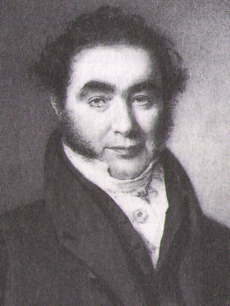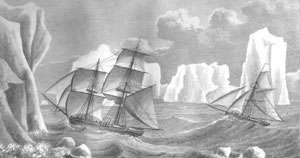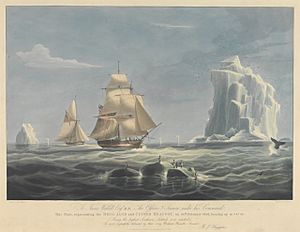James Weddell facts for kids
James Weddell (born August 24, 1787 – died September 9, 1834) was a British sailor, navigator, and seal hunter. In February 1823, he sailed further south than anyone before him. He reached a latitude of 74° 15′ S, which is about 532 statute miles south of the Antarctic Circle. This area of the Southern Ocean is now called the Weddell Sea, named after him.
Contents
James Weddell was born in Ostend, a town on the coast of Belgium. His father was a Scottish sea captain. James started working on ships at a very young age, so he did not get much formal schooling. However, he did learn to read and write.
He began his career on merchant ships, which carried goods for trade. He worked on coal transport vessels and made several trips to the West Indies. In 1808, he joined the Royal Navy. There, he studied navigation and quickly moved up in rank, eventually becoming a captain.
He served on the ship HMS Hope in 1813. After the Napoleonic War ended, he left the Royal Navy in 1816. For a while, he continued working on merchant ships, sailing to the West Indies.
Antarctic Expeditions
In 1819, James Weddell met James Strachan, a shipbuilder. Strachan and his partner, James Mitchell, owned a ship called the Jane. This ship was originally from America but was refitted for seal hunting.
News had just spread about the discovery of the South Shetland Islands. Weddell believed they could find many seals there and make a lot of money. His first trip as captain of the Jane took him to the Falkland Islands and then further south. He returned with a full cargo of seals, and the trip was very successful. Because of this, Strachan and Mitchell had a second ship, the Beaufoy, built.
From 1821 to 1822, Weddell took both ships to the South Shetland Islands. However, many other seal hunters were already in the area. Seals were becoming scarce, even though the islands had only been discovered two years earlier. So, Weddell decided to look for new hunting grounds.
On November 22, 1821, Michael McCleod, the captain of the Beaufoy, sighted the South Orkney Islands. This was a new discovery, made just a few days after other explorers had also seen them. They hunted for seals there and returned to England in July.
Record-Breaking Southern Voyage
On his third voyage, from 1822 to 1824, Weddell again commanded the Jane. The Beaufoy was captained by Matthew Brisbane. They sailed back to the South Orkneys. However, seal hunting was still not very good. After searching for land between the South Shetlands and the South Orkneys without success, they decided to sail south. They hoped to find better sealing areas.
The weather was unusually calm and mild. On February 20, 1823, the two ships reached latitude 74°15′S and longitude 34°16′45″W. This was the furthest south any ship had ever sailed at that time! They saw a few icebergs, but no land. Weddell thought that the sea might continue all the way to the South Pole. If they had sailed for two more days, they would have reached Coats Land, which is east of the Weddell Sea. However, Weddell decided to turn back.
After setting their course north, Weddell celebrated their achievement with the crew. They raised their flags, fired a gun, and cheered. The area they had explored was later named the Weddell Sea in his honor. This region was not visited again until 1911.
Weddell then sailed north to South Georgia to continue hunting for seals. They spent the winter at the Falkland Islands. In November 1823, they sailed again for the South Shetlands. The two ships separated in early 1824. Weddell returned to the Falklands in March 1824 and then headed back to England, arriving in July.
The Weddell seal was discovered and named in the 1820s during these expeditions led by James Weddell.
Weddell's record for sailing so far south, three degrees beyond what James Cook had achieved, surprised many people. Weddell was encouraged to write a book about his voyages. The first edition came out in 1825. A second, larger edition was published in 1827, including more information from the Beaufoy.
Later Life and Challenges
Weddell offered to return to the far southern latitudes for the British Admiralty, but his offer was declined. Instead, he went back to trading along the warmer Atlantic coasts. In 1829, he was again the master of the Jane. However, on a trip from Buenos Aires to Gibraltar, the Jane began to leak badly and had to be abandoned near the Azores. Weddell and his cargo were moved to another ship to continue to England. But this ship also ran aground on Pico Island, and Weddell barely survived.
The loss of the Jane meant that Weddell had to find new work as a ship's master. In September 1830, he left England as the master of the ship Eliza. He sailed to the Swan River Colony in western Australia and then to Tasmania. He returned to England in 1832.
James Weddell died on September 9, 1834, when he was 47 years old. He was buried in the churchyard of St Clement Danes in London.
Commemorations
Three places are named after James Weddell:
- The Weddell Sea in the Southern Ocean.
- Weddell Islands in the South Orkney Islands.
- Weddell Island in the Falkland Islands.
The Weddell seal is also named after him.
See also
 In Spanish: James Weddell para niños
In Spanish: James Weddell para niños




